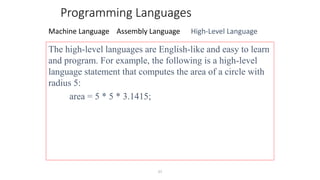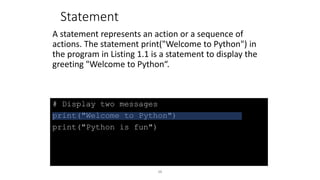This document outlines the grading structure, textbooks, and key concepts for an applied programming course in Python. It discusses the following main points:
- Grading is based on quizzes, assignments, a project, class participation, midterm, and final exam.
- The programming process involves 5 main steps: defining the problem, planning the solution, coding, testing, and documenting. Common planning tools include top-down design, algorithms, and flowcharts.
- Programming constructs allow for sequential, conditional, and repetitive control structures to structure program logic and flow. These include if/else statements, loops, and functions.
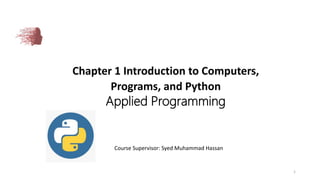








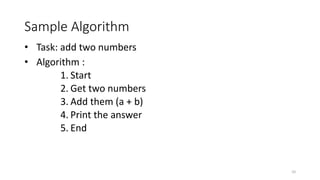


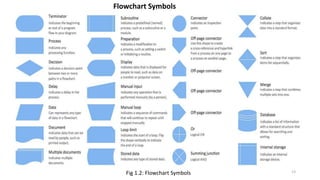






![2. Selection Control Structure (Selection Logic or Conditional Flow):
In it there are various conditions on the basis of which one
module is selected out of several given modules. The structures
which implement this logic are called conditional structures. The
conditional structures can be divided into following categories:
1. Single Alternative: This structure has the following form:
If condition, then
[Module A]
[End of If structure]
20](https://image.slidesharecdn.com/programminglecture1-220924100346-6d691b20/85/Programming_Lecture_1-pptx-20-320.jpg)
![According to this if the condition is true then
module A is executed. Otherwise, module A is
skipped. Its flowchart is:
2. Double Alternative: This structure has the
following form:
If condition, then
[Module A]
Else
[Module B]
[End of If structure]
According to this if the condition is true then
module A is executed. Otherwise, module B
is executed. 21
Single Alternative(cont.)](https://image.slidesharecdn.com/programminglecture1-220924100346-6d691b20/85/Programming_Lecture_1-pptx-21-320.jpg)
![3. Multiple Alternative: This structure has the following form:
If condition (1), then
[Module A1]
Else If condition (2), then
[Module A2]
.
.
.
Else If condition (n), then
[Module An]
Else
[Module B]
[End of If structure]
22](https://image.slidesharecdn.com/programminglecture1-220924100346-6d691b20/85/Programming_Lecture_1-pptx-22-320.jpg)

![4. Repetition Control Structure (Iteration Logic or Repetitive Flow): In
this structure, loops are implemented. Loop is used to implement
those statements which are to be repeated again and again until
some condition is satisfied. It implements while and for loops. Each
of these begin with Repeat statement. For example is case of Repeat-
while structure:
Repeat steps 1 to n while condition:
[Steps]
[End of Repeat-while structure]
Its flowchart is:
24](https://image.slidesharecdn.com/programminglecture1-220924100346-6d691b20/85/Programming_Lecture_1-pptx-24-320.jpg)


